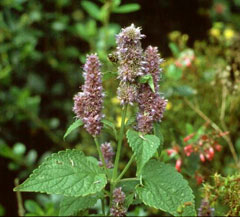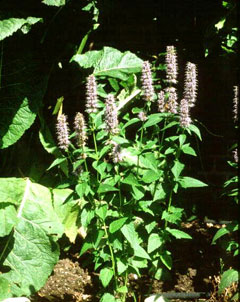 |
|
(c) ken Fern, Plants For A Future 2010 |
 |
| (c) ken Fern, Plants For A Future 2010 |
Translate this page:
Summary
Physical Characteristics

 Agastache foeniculum is a PERENNIAL growing to 0.9 m (3ft) by 0.4 m (1ft 4in) at a fast rate.
Agastache foeniculum is a PERENNIAL growing to 0.9 m (3ft) by 0.4 m (1ft 4in) at a fast rate.
See above for USDA hardiness. It is hardy to UK zone 8 and is not frost tender. It is in flower in July, and the seeds ripen in August. The species is hermaphrodite (has both male and female organs) and is pollinated by Bees. The plant is self-fertile.
It is noted for attracting wildlife.
Suitable for: light (sandy) and medium (loamy) soils and prefers well-drained soil. Suitable pH: mildly acid, neutral and basic (mildly alkaline) soils. It cannot grow in the shade. It prefers dry or moist soil.
UK Hardiness Map
US Hardiness Map
Synonyms
A. anethiodorum. (Nutt.)Britt.
Plant Habitats
Cultivated Beds;
Edible Uses
Edible Parts: Flowers Leaves
Edible Uses: Drink Tea
Leaves and flowers - raw or cooked. They are used as a flavouring in raw or cooked dishes[108, 177, 257]. Excellent raw, they have a sweet aniseed flavour and are one of our favourite flavourings in salads[K]. They make a delicious addition to the salad bowl[183] and can also be used to flavour cooked foods, especially acid fruits[K].The only drawback to the leaves is that they tend to have a drying effect in the mouth and so cannot be eaten in quantity[K]. A pleasant tasting tea is made from the leaves[46, 61, 161, 183].
References More on Edible Uses
Medicinal Uses
Plants For A Future can not take any responsibility for any adverse effects from the use of plants. Always seek advice from a professional before using a plant medicinally.
Cardiac Diaphoretic Pectoral Poultice
The leaves are cardiac and diaphoretic[222, 238, 257]. An infusion of the leaves is used in the treatment of colds, fevers, weak heart etc[222]. When left to go cold, the infusion is used to treat pains in the chest (such as when the lungs are sore from too much coughing)[207]. A poultice of leaves and stems can be used to treat burns[257].
References More on Medicinal Uses
The Bookshop: Edible Plant Books
Our Latest books on Perennial Plants For Food Forests and Permaculture Gardens in paperback or digital formats.

Edible Tropical Plants
Food Forest Plants for Hotter Conditions: 250+ Plants For Tropical Food Forests & Permaculture Gardens.
More

Edible Temperate Plants
Plants for Your Food Forest: 500 Plants for Temperate Food Forests & Permaculture Gardens.
More

More Books
PFAF have eight books available in paperback and digital formats. Browse the shop for more information.
Shop Now
Other Uses
References More on Other Uses
Cultivation details
Prefers a sunny position and a dry well-drained soil[187, 200]. This species is not hardy in the colder areas of the country, it tolerates temperatures down to between -5 and -10°c[200]. The young growth in spring is very susceptible to slug damage[K]. The flowering plants are very attractive to bees and butterflies[K]. There is at least one named variety. 'Texas American' has an anise-pennyroyal fragrance and is used in a similar way to the species[183]. The plant is heat tolerant in zones 12 through 5. (Plant Hardiness Zones show how well plants withstand cold winter temperatures.
Plant Heat Zones show when plants would start suffering from the heat.
The Plant Heat Zone map is based on the number of "heat days" experienced in a given area where the temperature climbs to over 86 degrees F (30°C).
At this temperature, many plants begin to suffer physiological damage. Heat Zones range from 1 (no heat days) to 12 (210 or more heat days).
For example Heat Zone. 11-1 indicates that the plant is heat tolerant in zones 11 through 1.) For polyculture design as well as the above-ground architecture (form - tree, shrub etc. and size shown above) information on the habit and root pattern is also useful and given here if available. The plant growth habit is a clumper with limited spread [1-2]. The root pattern is flat with shallow roots forming a plate near the soil surface [1-2].
References Carbon Farming Information and Carbon Sequestration Information
Temperature Converter
Type a value in the Celsius field to convert the value to Fahrenheit:
Fahrenheit:
The PFAF Bookshop
Plants For A Future have a number of books available in paperback and digital form. Book titles include Edible Plants, Edible Perennials, Edible Trees,Edible Shrubs, Woodland Gardening, and Temperate Food Forest Plants. Our new book is Food Forest Plants For Hotter Conditions (Tropical and Sub-Tropical).
Shop Now
Plant Propagation
Seed - sow spring in a greenhouse and only just cover the seed. The seed usually germinates in 1 - 3 months at 13°c[133]. Prick out the seedlings into individual pots when they are large enough to handle and grow them on in the greenhouse for their first year. Plant out in late spring or early summer[K]. Division in spring. Fairly simple, if large divisions are used it is possible to plant them straight out into their permanent positions. Basal cuttings of young shoots in spring[111]. Harvest the young shoots when they are about 10 - 15cm tall and pot them up in a lightly shaded position in a greenhouse. They should root within 3 weeks and can be planted out in the summer or following spring.
Other Names
If available other names are mentioned here
Blue Giant Hyssop, Blue Giant-hyssop, Lavender Hyssop, Licorice Mint, Wonder Honey Plant, Anise Hyssop, Anise mint [1-4].
Native Range
NORTHERN AMERICA: Canada, Northwest Territories (southwest). Ontario (west), Saskatchewan, Alberta, Manitoba, British Columbia, United States, Iowa, Minnesota, Nebraska (northwest), North Dakota, South Dakota, Wisconsin, Colorado (north-central), Montana (west), Wyoming (east),
Weed Potential
Right plant wrong place. We are currently updating this section.
Please note that a plant may be invasive in one area but may not in your area so it's worth checking.
Conservation Status
IUCN Red List of Threatened Plants Status :

Growth: S = slow M = medium F = fast. Soil: L = light (sandy) M = medium H = heavy (clay). pH: A = acid N = neutral B = basic (alkaline). Shade: F = full shade S = semi-shade N = no shade. Moisture: D = dry M = Moist We = wet Wa = water.
Now available:
Food Forest Plants for Mediterranean Conditions
350+ Perennial Plants For Mediterranean and Drier Food Forests and Permaculture Gardens.
[Paperback and eBook]
This is the third in Plants For A Future's series of plant guides for food forests tailored to
specific climate zones. Following volumes on temperate and tropical ecosystems, this book focuses
on species suited to Mediterranean conditions—regions with hot, dry summers and cool, wet winters,
often facing the added challenge of climate change.
Read More
Expert comment
Author
(Pursh.)Kuntze.
Botanical References
43200
Links / References
For a list of references used on this page please go here
Readers comment